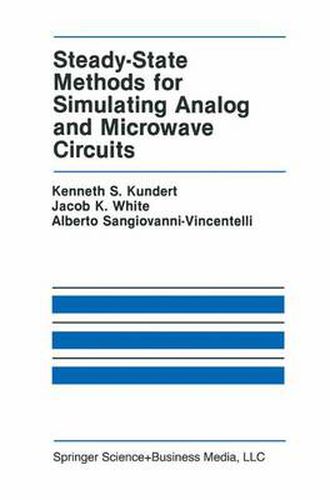Readings Newsletter
Become a Readings Member to make your shopping experience even easier.
Sign in or sign up for free!
You’re not far away from qualifying for FREE standard shipping within Australia
You’ve qualified for FREE standard shipping within Australia
The cart is loading…






This title is printed to order. This book may have been self-published. If so, we cannot guarantee the quality of the content. In the main most books will have gone through the editing process however some may not. We therefore suggest that you be aware of this before ordering this book. If in doubt check either the author or publisher’s details as we are unable to accept any returns unless they are faulty. Please contact us if you have any questions.
The motivation for starting the work described in this book was the interest that Hewlett-Packard’s microwave circuit designers had in simulation techniques that could tackle the problem of finding steady state solutions for nonlinear circuits, particularly circuits containing distributed elements such as transmission lines. Examining the problem of computing steady-state solutions in this context has led to a collection of novel numerical algorithms which we have gathered, along with some background material, into this book. Although we wished to appeal to as broad an audience as possible, to treat the subject in depth required maintaining a narrow focus. Our compromise was to assume that the reader is familiar with basic numerical methods, such as might be found in [dahlquist74] or [vlach83], but not assume any specialized knowledge of methods for steady-state problems. Although we focus on algorithms for computing steady-state solutions of analog and microwave circuits, the methods herein are general in nature and may find use in other disciplines. A number of new algorithms are presented, the contributions primarily centering around new approaches to harmonic balance and mixed frequency-time methods. These methods are described, along with appropriate background material, in what we hope is a reasonably satisfying blend of theory, practice, and results. The theory is given so that the algorithms can be fully understood and their correctness established.
$9.00 standard shipping within Australia
FREE standard shipping within Australia for orders over $100.00
Express & International shipping calculated at checkout
Stock availability can be subject to change without notice. We recommend calling the shop or contacting our online team to check availability of low stock items. Please see our Shopping Online page for more details.
This title is printed to order. This book may have been self-published. If so, we cannot guarantee the quality of the content. In the main most books will have gone through the editing process however some may not. We therefore suggest that you be aware of this before ordering this book. If in doubt check either the author or publisher’s details as we are unable to accept any returns unless they are faulty. Please contact us if you have any questions.
The motivation for starting the work described in this book was the interest that Hewlett-Packard’s microwave circuit designers had in simulation techniques that could tackle the problem of finding steady state solutions for nonlinear circuits, particularly circuits containing distributed elements such as transmission lines. Examining the problem of computing steady-state solutions in this context has led to a collection of novel numerical algorithms which we have gathered, along with some background material, into this book. Although we wished to appeal to as broad an audience as possible, to treat the subject in depth required maintaining a narrow focus. Our compromise was to assume that the reader is familiar with basic numerical methods, such as might be found in [dahlquist74] or [vlach83], but not assume any specialized knowledge of methods for steady-state problems. Although we focus on algorithms for computing steady-state solutions of analog and microwave circuits, the methods herein are general in nature and may find use in other disciplines. A number of new algorithms are presented, the contributions primarily centering around new approaches to harmonic balance and mixed frequency-time methods. These methods are described, along with appropriate background material, in what we hope is a reasonably satisfying blend of theory, practice, and results. The theory is given so that the algorithms can be fully understood and their correctness established.